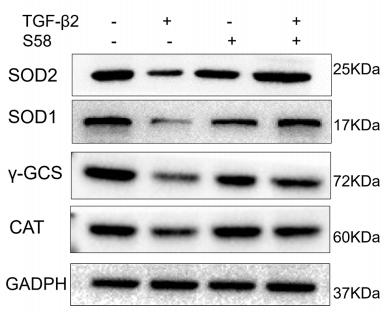Catalase Antibody - #DF7545
| Product: | Catalase Antibody |
| Catalog: | DF7545 |
| Description: | Rabbit polyclonal antibody to Catalase |
| Application: | WB IHC IF/ICC |
| Reactivity: | Human, Mouse, Rat |
| Prediction: | Bovine, Sheep, Rabbit, Dog |
| Mol.Wt.: | 60 kDa; 60kD(Calculated). |
| Uniprot: | P04040 |
| RRID: | AB_2841044 |
Related Downloads
Protocols
Product Info
*The optimal dilutions should be determined by the end user.
*Tips:
WB: For western blot detection of denatured protein samples. IHC: For immunohistochemical detection of paraffin sections (IHC-p) or frozen sections (IHC-f) of tissue samples. IF/ICC: For immunofluorescence detection of cell samples. ELISA(peptide): For ELISA detection of antigenic peptide.
Cite Format: Affinity Biosciences Cat# DF7545, RRID:AB_2841044.
Fold/Unfold
Cas1; CAT; CATA_HUMAN; Catalase; Cs1; MGC138422; MGC138424;
Immunogens
- P04040 CATA_HUMAN:
- Protein BLAST With
- NCBI/
- ExPASy/
- Uniprot
MADSRDPASDQMQHWKEQRAAQKADVLTTGAGNPVGDKLNVITVGPRGPLLVQDVVFTDEMAHFDRERIPERVVHAKGAGAFGYFEVTHDITKYSKAKVFEHIGKKTPIAVRFSTVAGESGSADTVRDPRGFAVKFYTEDGNWDLVGNNTPIFFIRDPILFPSFIHSQKRNPQTHLKDPDMVWDFWSLRPESLHQVSFLFSDRGIPDGHRHMNGYGSHTFKLVNANGEAVYCKFHYKTDQGIKNLSVEDAARLSQEDPDYGIRDLFNAIATGKYPSWTFYIQVMTFNQAETFPFNPFDLTKVWPHKDYPLIPVGKLVLNRNPVNYFAEVEQIAFDPSNMPPGIEASPDKMLQGRLFAYPDTHRHRLGPNYLHIPVNCPYRARVANYQRDGPMCMQDNQGGAPNYYPNSFGAPEQQPSALEHSIQYSGEVRRFNTANDDNVTQVRAFYVNVLNEEQRKRLCENIAGHLKDAQIFIQKKAVKNFTEVHPDYGSHIQALLDKYNAEKPKNAIHTFVQSGSHLAAREKANL
Predictions
Score>80(red) has high confidence and is suggested to be used for WB detection. *The prediction model is mainly based on the alignment of immunogen sequences, the results are for reference only, not as the basis of quality assurance.
High(score>80) Medium(80>score>50) Low(score<50) No confidence
PTMs - P04040 As Substrate
| Site | PTM Type | Enzyme | Source |
|---|---|---|---|
| A2 | Acetylation | Uniprot | |
| S9 | Phosphorylation | Uniprot | |
| K16 | Ubiquitination | Uniprot | |
| K23 | Ubiquitination | Uniprot | |
| K38 | Acetylation | Uniprot | |
| K38 | Ubiquitination | Uniprot | |
| R47 | Methylation | Uniprot | |
| K77 | Ubiquitination | Uniprot | |
| Y84 | Phosphorylation | Uniprot | |
| K98 | Ubiquitination | Uniprot | |
| K105 | Ubiquitination | Uniprot | |
| T107 | Phosphorylation | Uniprot | |
| S114 | O-Glycosylation | Uniprot | |
| T115 | Phosphorylation | Uniprot | |
| T150 | Phosphorylation | Uniprot | |
| S167 | Phosphorylation | Q05655 (PRKCD) | Uniprot |
| Y231 | Phosphorylation | P42684 (ABL2) , P00519 (ABL1) , A0A173G4P4 (Abl fusion) | Uniprot |
| C232 | S-Nitrosylation | Uniprot | |
| K233 | Ubiquitination | Uniprot | |
| K237 | Acetylation | Uniprot | |
| K237 | Ubiquitination | Uniprot | |
| K243 | Ubiquitination | Uniprot | |
| S254 | O-Glycosylation | Uniprot | |
| Y260 | Phosphorylation | Uniprot | |
| K306 | Ubiquitination | Uniprot | |
| Y308 | Phosphorylation | Uniprot | |
| K315 | Ubiquitination | Uniprot | |
| Y358 | Phosphorylation | Uniprot | |
| Y370 | Phosphorylation | Uniprot | |
| Y379 | Phosphorylation | Uniprot | |
| Y386 | Phosphorylation | A0A173G4P4 (Abl fusion) , P42684 (ABL2) , P00519 (ABL1) | Uniprot |
| S422 | Phosphorylation | Uniprot | |
| Y425 | Phosphorylation | Uniprot | |
| Y447 | Phosphorylation | Uniprot | |
| C460 | S-Nitrosylation | Uniprot | |
| K468 | Acetylation | Uniprot | |
| K468 | Ubiquitination | Uniprot | |
| K476 | Acetylation | Uniprot | |
| K480 | Acetylation | Uniprot | |
| K480 | Ubiquitination | Uniprot | |
| K499 | Ubiquitination | Uniprot | |
| T511 | Phosphorylation | Uniprot | |
| S515 | Phosphorylation | Uniprot | |
| S517 | Phosphorylation | Uniprot |
Research Backgrounds
Occurs in almost all aerobically respiring organisms and serves to protect cells from the toxic effects of hydrogen peroxide. Promotes growth of cells including T-cells, B-cells, myeloid leukemia cells, melanoma cells, mastocytoma cells and normal and transformed fibroblast cells.
The N-terminus is blocked.
Peroxisome.
Homotetramer.
Belongs to the catalase family.
Research Fields
· Cellular Processes > Transport and catabolism > Peroxisome. (View pathway)
· Environmental Information Processing > Signal transduction > FoxO signaling pathway. (View pathway)
· Human Diseases > Neurodegenerative diseases > Amyotrophic lateral sclerosis (ALS).
· Metabolism > Amino acid metabolism > Tryptophan metabolism.
· Metabolism > Carbohydrate metabolism > Glyoxylate and dicarboxylate metabolism.
· Metabolism > Global and overview maps > Carbon metabolism.
· Organismal Systems > Aging > Longevity regulating pathway. (View pathway)
· Organismal Systems > Aging > Longevity regulating pathway - multiple species. (View pathway)
References
Application: WB Species: human Sample: HConFs
Restrictive clause
Affinity Biosciences tests all products strictly. Citations are provided as a resource for additional applications that have not been validated by Affinity Biosciences. Please choose the appropriate format for each application and consult Materials and Methods sections for additional details about the use of any product in these publications.
For Research Use Only.
Not for use in diagnostic or therapeutic procedures. Not for resale. Not for distribution without written consent. Affinity Biosciences will not be held responsible for patent infringement or other violations that may occur with the use of our products. Affinity Biosciences, Affinity Biosciences Logo and all other trademarks are the property of Affinity Biosciences LTD.

